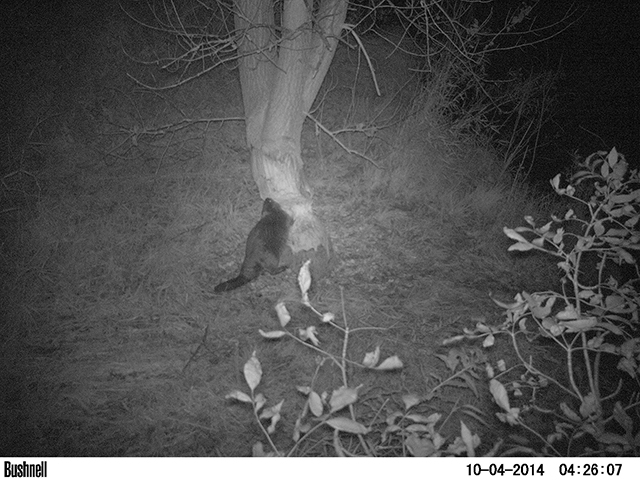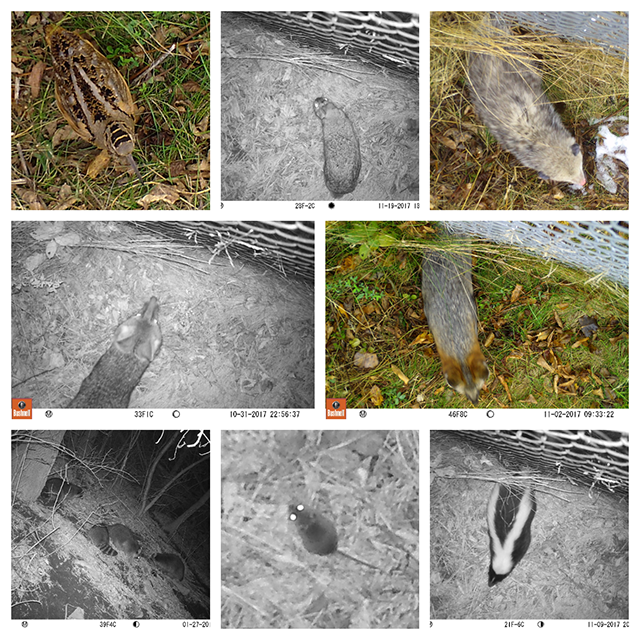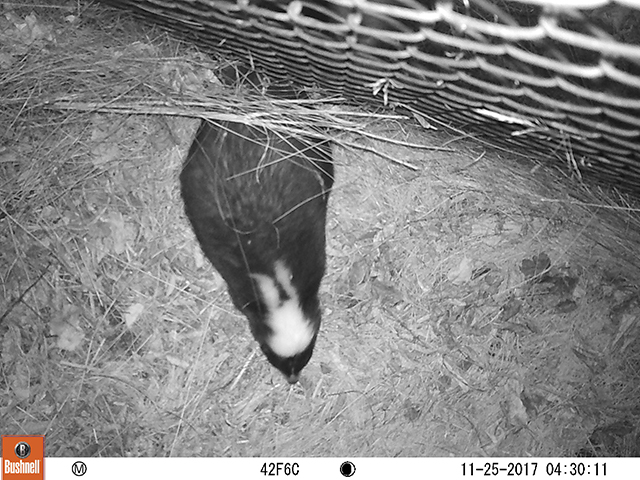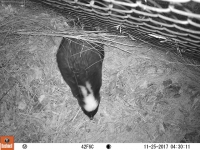
Web camera photo of a beaver chewing on a tree trunk.
Imagine being able to see what animals are doing any season, year-round. I would love to know where birds go in the rain or exactly how many of them are hiding in the dark hollow of that oak snag. Just how many white-footed mice scurry beneath the snow’s surface as the hungry raccoon scours the ground above in search of a meal? To answer some of these questions we placed wildlife cameras to document the creatures visiting our green spaces when we are not around to see them. Strategically placed wildlife cameras not only help tell us who is visiting our green spaces, but also provide an additional method for animal identification when trapping is not ideal.
We typically take down our wildlife cameras in the colder months because batteries die quickly in sub-zero temps and vandals sometimes find our cameras just too tempting to resist. However, at the end of 2017, we decided to put out a sacrificial camera, #44. We wanted to test the power of lithium batteries in winter and get an idea of just who may be around in one particular area of our property at Riverside Park in the colder months.
And boy did camera #44 deliver! From late-October 2017 – March 4th 2018, camera #44 documented 12 species (10 mammals). Add this to our visual observations throughout those same months (in the same exact area) and we documented 14 mammal species in one winter! SO much life!

So on a small, one-acre parcel of land, during a four month stretch from November-March, we were able to document 13 of our 16 active (non-migratory or non-hibernating) winter residents! This is an incredible number, especially when you consider the urban location of our green space!
For context, the life list of mammal species at Riverside Park is 26 species meaning that this winter we observed all but 14 from the total list.
Of our confirmed non-hibernating species, only the Norway rat, the muskrat, and the northern short-tailed shrew were able to elude our detection during that time. The delicate shrews were likely fighting under the cover of snow to survive the winter against very high mortality rates, the rats hanging closer to the warmth of a man-made structure, and the muskrats assumingly tucked away in an elaborate den along the bank of the Milwaukee River.
Many of us are familiar with the concept of hibernation, but the creatures that make it through winter without hibernating may be even more fascinating. Admire the armor-less beaver that survived the countless masses of thousand pound sheets of ice that careened into his den as the frozen river broke-up last week. Consider the woodchuck whose percentage of body fat grew so low that he emerged from hibernation early to climb a tree and eat the remaining, fermented fruit at the end of its branches. Think about the coyote whose ribs protruded so prominently that she risked sneaking into your neighbor’s backyard this morning to scarf down the week-old pizza crust that raccoons dug out of their garbage can last night. Look for the frost-bitten-eared opossum stealing an evening snack from below the backyard bird feeder. And the meadow vole debating whether the shadow just beyond the outline of that crab apple is a coyote. Surely it must be nerve-wracking. If nothing else, it’s admirable.

I may forever have to fill in the backstory of every creature I encounter because I will never have the omniscience I so desire, but it’s still pretty cool to consider the power we mortals hold. Or maybe more appropriately the power of one wildlife camera and the stories revealed on one parcel of land, one winter in 2017. The stories of numerous scrappy city creatures that survived, not on the hope of a cardinal’s spring song, but rather the inner-workings of some innate and little understood adaptability super power.





